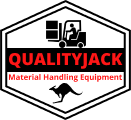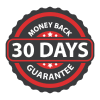You have no items in your shopping cart.
How to Prevent Forklift Tipping
Maintaining a proper center of gravity is the name of the game. The center of gravity of a forklift must stay between the tires of the machine. To maintain center of gravity, there are many factors. The following factors are important in keeping your forklift’s center of gravity in the ideal range at all times:
1. Load Center (front-to-back)
All forklifts have a specified load center. The load center is a number in inches that will tell an operator how far away from the front face of the forks the center of the load should be placed. When the load exceeds the load center and is overweight, the forklift is in real danger of tipping forward. Load elevation, weight, and distance from the front tire all have a huge impact on stability.
Your forklift might handle a 3,000 pound load near the front tires of your machine, but might be in serious danger of tipping when moved to the tips of the forks due to the change in the center of gravity. To offset heavy front loads, forklifts are built with huge counterweights at the very rear of the machine. Counterweights can be changed for varying load sizes.
Properly placed and elevated loads on flat surfaces will eliminate the risk of tipping over. Keep the laws of physics on your side by familiarizing yourself with that load limits of your forklift. A seasoned forklift driver will know the limits of his or her forklift.

2. Balance (side-to-side)
Since forklifts have more length than width, it’s actually very easy to tip a forklift on its side. Poor driving is the typical cause of a forklift tipping on its side. Most forklifts have very sharp turning. When sharp turns are combined with speed, tipping is imminent.
Load positioning also has an impact on side-to-side balance of a forklift. The higher the load is elevated, the higher chance the forklift has of tipping during turns. Objects that overhang on either side of the forks are prone to shift and throw the center of gravity off. A load shift that is severe enough will easily tip a forklift.

3. Thoroughly inspect your forklift
A properly maintained forklift is a safe forklift. There are several things on a forklift that could malfunction and throw a load out of balance, possible tipping the forklift. Forklifts recommend a regular maintenance schedule inspecting the following parts and vital signs:
- Hooks
- Heels
- Tips
- Oil pressure
- Radiator has no leaks
4. Drive carefully
Forklift manufacturers could easily build forklifts with less capabilities like shorter forks and reduced power to make forklifts safer, but it would severely hamper the effectiveness of the forklift. Manufacturers rely on forklift operators to use the machine as directed and not push the limits they were designed for. It’s up to responsible management to educate staff on proper forklift usage to reduce injuries in the workplace.
How to Prevent Forklift Tipping
Maintaining a proper center of gravity is the name of the game. The center of gravity of a forklift must stay between the tires of the machine. To maintain center of gravity, there are many factors. The following factors are important in keeping your forklift’s center of gravity in the ideal range at all times:
1. Load Center (front-to-back)
All forklifts have a specified load center. The load center is a number in inches that will tell an operator how far away from the front face of the forks the center of the load should be placed. When the load exceeds the load center and is overweight, the forklift is in real danger of tipping forward. Load elevation, weight, and distance from the front tire all have a huge impact on stability.
Your forklift might handle a 3,000 pound load near the front tires of your machine, but might be in serious danger of tipping when moved to the tips of the forks due to the change in the center of gravity. To offset heavy front loads, forklifts are built with huge counterweights at the very rear of the machine. Counterweights can be changed for varying load sizes.
Properly placed and elevated loads on flat surfaces will eliminate the risk of tipping over. Keep the laws of physics on your side by familiarizing yourself with that load limits of your forklift. A seasoned forklift driver will know the limits of his or her forklift.

2. Balance (side-to-side)
Since forklifts have more length than width, it’s actually very easy to tip a forklift on its side. Poor driving is the typical cause of a forklift tipping on its side. Most forklifts have very sharp turning. When sharp turns are combined with speed, tipping is imminent.
Load positioning also has an impact on side-to-side balance of a forklift. The higher the load is elevated, the higher chance the forklift has of tipping during turns. Objects that overhang on either side of the forks are prone to shift and throw the center of gravity off. A load shift that is severe enough will easily tip a forklift.

3. Thoroughly inspect your forklift
A properly maintained forklift is a safe forklift. There are several things on a forklift that could malfunction and throw a load out of balance, possible tipping the forklift. Forklifts recommend a regular maintenance schedule inspecting the following parts and vital signs:
- Hooks
- Heels
- Tips
- Oil pressure
- Radiator has no leaks
4. Drive carefully
Forklift manufacturers could easily build forklifts with less capabilities like shorter forks and reduced power to make forklifts safer, but it would severely hamper the effectiveness of the forklift. Manufacturers rely on forklift operators to use the machine as directed and not push the limits they were designed for. It’s up to responsible management to educate staff on proper forklift usage to reduce injuries in the workplace.









